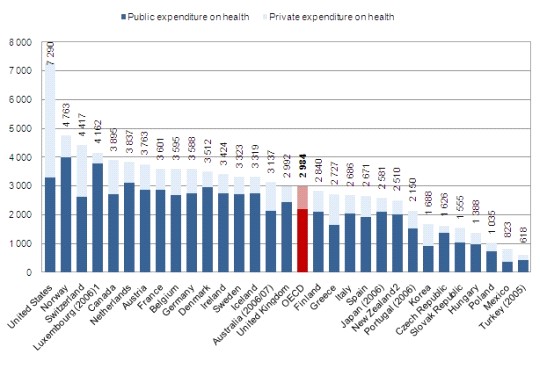Health at a Glance - 2009 - OECD Indicators
Expensive health care is not always the best health care, says OECD’s Health at a Glance
08/12/2009
Paris. 08/12/09 - New internationally comparable indicators on quality of care show progress in treating serious conditions such as cancer. However, despite increasing rates of chronic diseases such as asthma and diabetes, care for these conditions falls short of good practices in too many countries, resulting in deteriorating health and higher medical costs.
The United States and Canada have good cancer care, screening more people than most other countries and saving the lives of a greater number of cancer patients. Japan also has higher survival rates for people with cancer than most countries. The Netherlands, Italy, Switzerland and Germany provide good primary care, reducing costly hospital treatment for chronic conditions such as asthma or diabetes. But no one OECD country provides high quality care in all areas.
“There are opportunities for all countries to improve the performance of their health care system, and making such improvements does not necessarily require higher spending”, OECD Secretary-General Angel Gurria said.
Total health expenditure per capita, public and private,
2007

1. Health expenditure is for the insured population rather than
resident population. 2. Current health expenditure (Source: OECD
Health Data 2009).
Health at a Glance 2009 also looks at acute care for life-threatening conditions such as heart attack and stroke, showing that less than 5% of people hospitalised after a heart attack die within 30 days of being admitted to hospital. Iceland, Denmark, Sweden and Norway do best, with death rates of only around 3%. Health care is improving at an astonishing speed in some areas: over the past 5 years, for example, many more people are surviving after a stroke.
Large variations in health spending
Health at a Glance 2009 shows that the United States spends more
on health - 7290 USD per capita in 2007 - than any other country.
This is almost two and a half times greater than the OECD average
of 2984 USD, adjusted for purchasing power parity. Luxembourg,
Norway and Switzerland also spend far more than the OECD average.
At the other end of the scale, in Turkey and Mexico health
expenditure was less than one-third the OECD average.
Key indicators presented in Health at a Glance 2009 provide
information on health status and the determinants of health,
including the growing rates of child and adult obesity, which are
likely to drive health spending higher in the coming decades. This
edition also has new data on access to care, showing that all OECD
countries provide universal or near-universal coverage for a core
set of health services, except the United States, Mexico and
Turkey.
More information is also available at www.oecd.org/health/healthataglance